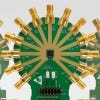Introduction
Radio Frequency (RF) communication has become an integral part of modern electronics, enabling wireless data transfer between devices. Arduino, a popular open-source electronics platform, provides an excellent opportunity to explore and experiment with RF technology. In this comprehensive article, we will delve into the intricacies of sending data through an RF module using Arduino.
Understanding RF Communication
Before we dive into the implementation details, it is essential to grasp the fundamentals of RF communication. Radio frequency refers to the oscillation rate of electromagnetic waves within the radio wave portion of the electromagnetic spectrum. These waves can carry information over long distances and are widely used in various applications, including broadcasting, telecommunications, and wireless data transfer.
RF Modules
RF modules are electronic devices that enable wireless communication between two or more points. They consist of a transmitter and a receiver, allowing data to be transmitted and received wirelessly. Arduino boards can interface with various RF modules, facilitating wireless data exchange with other devices or systems.
Setting up the Hardware
To send data through an RF module using Arduino, you will need the following components:
- Arduino board (e.g., Arduino Uno, Arduino Nano, Arduino Mega)
- RF module (e.g., nRF24L01+, HC-12, FS1000A)
- Breadboard
- Jumper wires
- USB cable (for Arduino programming)
Connecting the RF Module
The specific connection process may vary depending on the RF module you are using. However, in general, you will need to connect the following pins:
Refer to the datasheet or documentation of your specific RF module for the exact pin mappings and connection details.
Programming the Arduino
Once the hardware is set up correctly, you can begin programming the Arduino to send data through the RF module. The programming process typically involves two main steps:
- Installing the required libraries
- Writing the Arduino sketch
Installing Libraries
Most RF modules have dedicated libraries that simplify the communication process. These libraries provide high-level functions and abstractions, allowing you to focus on the data transfer logic rather than low-level implementation details.
For example, if you are using the nRF24L01+ module, you will need to install the RF24 library by following these steps:
- Open the Arduino IDE.
- Go to Sketch > Include Library > Manage Libraries.
- Search for “RF24” and install the latest version of the library.
Writing the Arduino Sketch
After installing the necessary libraries, you can write the Arduino sketch to send data through the RF module. Here is a basic example using the nRF24L01+ module:
#include <SPI.h>
#include <nRF24L01.h>
#include <RF24.h>// Define the RF module pins
#define CE_PIN 9
#define CSN_PIN 10// Create an instance of the RF24 library
RF24 radio(CE_PIN, CSN_PIN);// Define the radio pipe addresses for communication
const uint64_t pipeOut = 0xE8E8F0F0E1LL;
const uint64_t pipeIn = 0xF0F0F0F0D2LL;void setup() {
Serial.begin(9600); // Initialize the radio module
radio.begin(); // Set the transmitter and receiver addresses
radio.openWritingPipe(pipeOut);
radio.openReadingPipe(1, pipeIn); // Start the radio communication
radio.startListening();
}void loop() {
// Create a buffer to store the data
char dataToSend[32] = "Hello, Arduino!"; // Stop listening and prepare for sending data
radio.stopListening(); // Send the data
bool success = radio.write(&dataToSend, sizeof(dataToSend)); if (success) {
Serial.println("Data sent successfully!");
} else {
Serial.println("Failed to send data.");
} // Start listening again for incoming data
radio.startListening(); // Add a delay to avoid overwhelming the radio module
delay(1000);
}
In this example, the setup() function initializes the radio module, sets the transmitter and receiver addresses, and starts listening for incoming data. The loop() function creates a buffer containing the data to be sent, stops listening, sends the data using the radio.write() function, and then starts listening again for incoming data.
Note that the specific implementation details may vary depending on the RF module you are using and the desired functionality (e.g., sending and receiving data, handling acknowledgments, error handling, etc.).
Frequently Asked Questions (FAQ)
- Q: What is the maximum range of RF communication using Arduino? A: The maximum range of RF communication depends on various factors, including the RF module used, transmit power, antenna design, and environmental conditions. Generally, low-cost RF modules have a range of a few meters to tens of meters indoors, and up to hundreds of meters in ideal outdoor conditions.
- Q: How do I ensure secure communication using RF modules? A: Most RF modules support encryption techniques to secure the data transmission. Additionally, you can implement your own encryption algorithms or use secure communication protocols like HTTPS or SSL/TLS when transmitting sensitive data.
- Q: Can I use multiple RF modules with the same Arduino? A: Yes, it is possible to use multiple RF modules with the same Arduino board. However, you need to ensure that each module operates on a different communication channel or frequency to avoid interference and data collisions.
- Q: How do I troubleshoot communication issues with the RF module? A: Troubleshooting RF communication issues can involve several steps, such as checking the hardware connections, verifying the power supply, ensuring the module is properly initialized, and testing the communication range. Additionally, you can use serial monitoring or debugging tools to identify and resolve potential software or hardware-related issues.
- Q: Can I use RF modules for long-range communication? A: While low-cost RF modules have limited range, there are specialized long-range RF modules available for applications that require extended communication distances. These modules often operate in licensed frequency bands and may require additional certifications or approvals for use.
By following the steps outlined in this article, you can successfully send data through an RF module using Arduino. Remember to consult the documentation and datasheets for your specific RF module and Arduino board for accurate pinouts and configuration details.
